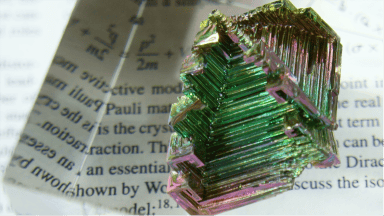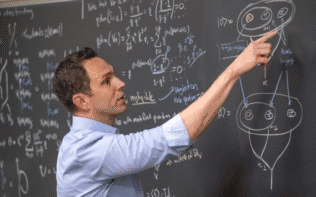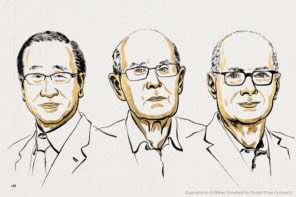
Bismuth has puzzled scientists for nearly 20 years. Notably, the question of whether it is topological – that is, whether electrons behave differently on its surface than they do inside it – gets different answers depending on whether you ask a theorist or an experimentalist. Researchers in Japan now say they have found a way to resolve this conflict. A mechanism called surface relaxation, they report, may have masked or “blocked” bismuth’s true topological nature.
The classic way of describing topology is to compare objects that have a hole, such as a doughnut or a coffee mug, with objects that don’t, such as a muffin. Although we usually think of doughnuts as having more in common with muffins than with mugs – you can’t eat a mug – the fact that they have the same number of holes means the mug and doughnut share topological features that the muffin does not.
While no-one has ever wondered whether they can eat an electron, scientists have long been curious about whether materials conduct electricity. As it turns out, topology is one way of answering that question.
“Previously, people classified materials as metallic or insulating,” says Yuki Fuseya, a quantum solid state physicist at Kobe University. Beginning in the 2000s, however, Fuseya says scientists started focusing more on the topology of the electrons’ complex wavefunctions. This enriched our understanding of how materials behave, because wavefunctions with apparently different shapes can share important topological features.
For example, if the topology of certain wavefunctions on a material’s surface corresponds to that of apparently different wavefunctions within its bulk, the material may be insulating in its bulk, yet still able to conduct electricity on its surface. Materials with this property are known as topological insulators, and they have garnered a huge amount of interest due to the possibility of exploiting them in quantum computing, spintronics and magnetic devices.
Topological or not topological
While it’s not possible to measure the topology of wavefunctions directly, it is generally possible to detect whether a material supports certain surface states. This information can then be used to infer something about its bulk using the so-called bulk-edge state correspondence.
In bismuth, the existence of these surface states ought to indicate that the bulk material is topologically trivial. However, experiments have delivered conflicting information.
Fuseya was intrigued. “If you look at the history of solid-state physics, many physical phenomena were found firstly in bismuth,” he tells Physics World. Examples include diamagnetism, the Seebeck effect and the Shubnikov-de Haas effect, as well as phenomena related to the giant spin Hall effect and the potential for Turing patterns that Fuseya discovered himself. “That’s one of the reasons why I am so interested in bismuth,” he says.
Fuseya’s interest attracted colleagues with different specialisms. Using density functional theory, Rikako Yaguchi of the University of Electro-Communications in Tokyo calculated that layers of bismuth’s crystal lattice expand, or relax, by 3-6% towards the surface. According to Fuseya, this might not have seemed noteworthy. However, since the team was already looking at bismuth’s topological properties, another colleague, Kazuki Koie, went ahead and calculated how this lattice expansion changed the material’s surface wavefunction.
These calculations showed that the expansion is, in fact, significant. This is because bismuth is close to the topological transition point, where a change in parameters can flip the shape of the wavefunction and give topological properties to a material that was once topologically trivial. Consequently, the reason it is not possible to observe surface states indicating that bulk bismuth is topologically trivial is that the material is effectively different – and topologically non-trivial – on its surface.
Topological blocking
Although “very surprised” at first, Fuseya says that after examining the physics in more detail, they found the result “quite reasonable”. They are now looking for evidence of similar “topological blocking” in other materials near the transition point, such as lead telluride and tin telluride.
“It is remarkable that there are still big puzzles when trying to match data to the theoretical predictions,” says Titus Mangham Neupert, a theoretical physicist at the University of Zurich, Switzerland, who was not directly involved in the research. Since “so many compounds that made the headlines in topological physics” contain bismuth, Neupert says it will be interesting to re-evaluate existing experiments and conceive new ones. “In particular, the implication for higher-order topology could be tested,” he says.

Ubiquity of topological materials revealed in catalogues containing thousands of substances
Fuseya’s team is already studying how lattice relaxation might affect hinges where two surfaces come together. In doing so, they hope to understand why angle resolved photoemission spectroscopy (ARPES), which probes surfaces, yields results that contradict those from scanning tunnelling microscopy experiments, which probe hinges. “Maybe we can find a way to explain every experiment consistently,” Fuseya says. The insights they gain, he adds, might also be useful for topological engineering: by bending a material, scientists could alter its lattice constants, and thereby tailor its topological properties.
This aspect also interests Zeila Zanolli and Matthieu Verstraete of Utrecht University in the Netherlands. Though not involved in the current study, they had previously shown that free-standing two-dimensional bismuth (bismuthene) can take on several geometric structures in-plane – not all of which are topological – depending on the material’s strain, bonding coordination and directionality. The new work, they say, “opens the way to (computational) design of topological materials, playing with symmetries, strain and the substrate interface”.
The research is published in Physical Review B.



